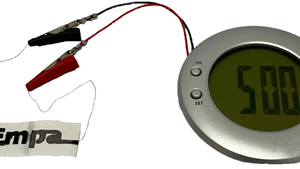Nick Kilvert* says a disposable printed paper battery, activated by water, may help reduce electronic waste.
 Scientists have developed a battery made mostly from paper and activated by water that they think can help clean up the disposable battery waste stream.
Scientists have developed a battery made mostly from paper and activated by water that they think can help clean up the disposable battery waste stream.
Though only at proof-of-concept stage, the paper-based battery was able to power the digital display of an alarm clock, according to research published today in Scientific Reports.
The battery was able to achieve a maximum stable voltage of 1.2 volts, compared to a standard AA battery’s 1.5 volts, the researchers from the Swiss Federal Laboratories for Materials Science and Technology said.
They think a refined version of the battery could be used in applications where single-use electronics are necessary, such as in some medical diagnostic devices, smart packaging or environmental sensing devices.
It could also potentially provide a safer alternative to button batteries, which have been implicated in deaths of children.
“Another application area may be within the expanding field of soft robotics,” said study co-author Gustav Nystrom.
“New biodegradable energy sources may open up completely new possibilities to design transient robots.”
Digital disruption and rapidly changing technology made the development of a biodegradable battery especially timely, Dr Nystrom said.
“We see trends in increasing connectivity, more and more interconnected devices, and we also see trends in more and more electronics being more efficient, requiring low power.
“We also see increasing use of single-use electronics and evidence of poor recycle-ability of these devices, which leads to ever-increasing amounts of electronic waste.”
Miaoqiang Lyu, from the University of Queensland’s Australian Institute for Bioengineering and Nanotechnology, said one of the strengths of the paper-based battery is that it can be made using fairly basic printing technology.
“It’s low cost, high safety and low toxicity,” Dr Lyu, who wasn’t involved with the research, said.
“You can pick up the battery just using your fingers without any gloves, which is very safe compared to other batteries.”
How does it work?
To create the battery, the researchers started with a strip of paper that had been immersed in saltwater and left to dry.
The positive terminal or cathode was made by printing ink containing graphite flakes on one side of the paper strip.
The negative terminal, or anode, was made by printing the flip side of the paper with ink infused with zinc powder.
Both sides were then printed over with ink containing graphite flakes and carbon black — a powder similar to soot leftover from the partial combustion of, for instance, coal tar or even vegetable matter.
This top layer of conductive ink connected both the negative and positive sides to one end of the paper, where two wires were affixed with a wax compound.
When the paper got wet, the salt dissolved, releasing charged ions throughout the paper.
When the ions made contact with the zinc at the negative terminal, it released electrons, which are negatively charged.
Connecting the wires to an electrical device completed the circuit, allowing the electrons to flow as a current from the anode to the cathode via the device.
At the cathode, the electrons were discharged to the air.
Dr Lyu says because the device is activated by water, it could have an extremely long shelf life as long as it is kept dry.
Some kinks to be ironed out
While the technology is promising, Dr Lyu says there are some limitations to how the batteries can be used.
The first is the low power density of the ink-printed paper.
“[They were getting] a few hundred microwatts per square centimetre.
“This power density is pretty low, which limits its application in the market,” he said.
However, that could be increased by making the battery (which is printed paper) larger, or by connecting several batteries in sequence.
A second issue is that the battery uses water as the solvent to dissolve the sodium chloride, but at the same time, the cathode must be open to the air to release electrons.
“This could cause another problem,” Dr Lyu said.
“When the battery is open, the water would gradually evaporate.
“If the water evaporates, [the battery] will not work anymore.”
Under their controlled conditions, the researchers were able to operate their battery for around an hour before it dried out.
Dr Nystrom says they’re currently working on improving the performance of the battery, and on streamlining production volumes and costs.
“We are currently looking at further improving the performance of the devices as well as improved processing with other manufacturing and printing techniques,” he said.
“We’re really excited about this technology, which is an example of sustainable materials-driven research … that can be combined into systems that help solve important functions in our society, while being safe for the environment.”
*Nick Kilvert is the online environment reporter in the ABC RN science unit. You can follow him on Twitter at @nkilvert.
This article first appeared at abc.net.au



